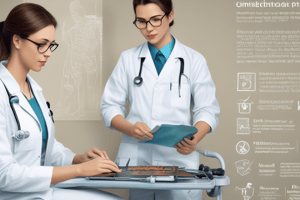Podcast
Questions and Answers
Which position is suitable for the examination of the scoliosis?
Which position is suitable for the examination of the scoliosis?
- Supine position
- Dorsal recumbent position
- Standing position
- Sitting position (correct)
In which position is the patient flat on their back with knees bent and feet flat on the exam table?
In which position is the patient flat on their back with knees bent and feet flat on the exam table?
- Dorsal recumbent position (correct)
- Lithotomy position
- Sims' position
- Prone position
What is the purpose of the knee-chest position?
What is the purpose of the knee-chest position?
- Auscultation of heart & lungs
- Pelvic examination
- Examination of the spine and legs (correct)
- Assessment for inguinal hernia
Which position involves the patient lying on their abdomen with hands at the side and head turned to the side?
Which position involves the patient lying on their abdomen with hands at the side and head turned to the side?
When would a lithotomy position be typically used?
When would a lithotomy position be typically used?
Which position involves sitting with the backrest elevated at a 90° angle?
Which position involves sitting with the backrest elevated at a 90° angle?
During a physical examination, which position would be most appropriate for the assessment of the rectum, vagina, or both?
During a physical examination, which position would be most appropriate for the assessment of the rectum, vagina, or both?
Which position involves the patient lying flat on their back with arms at the side and legs extended, for examination of the front of the body and breasts?
Which position involves the patient lying flat on their back with arms at the side and legs extended, for examination of the front of the body and breasts?
In which position would a patient be placed for auscultation of the heart and lungs?
In which position would a patient be placed for auscultation of the heart and lungs?
Which position allows the patient to lie on their abdomen with hands at the side and head turned to the side for examination of the spine and legs?
Which position allows the patient to lie on their abdomen with hands at the side and head turned to the side for examination of the spine and legs?
For which examination would the lithotomy position be most appropriate?
For which examination would the lithotomy position be most appropriate?
Which position involves the patient kneeling on the exam table with buttocks raised while head and chest remain flat for rectal examination?
Which position involves the patient kneeling on the exam table with buttocks raised while head and chest remain flat for rectal examination?
In which position would a patient typically lie flat on their back with knees bent and feet flat on the exam table?
In which position would a patient typically lie flat on their back with knees bent and feet flat on the exam table?
Study Notes
Patient Positions for Examination
- The suitable position for examining scoliosis is not specified.
- The supine position involves the patient lying flat on their back with knees bent and feet flat on the exam table.
- The knee-chest position is used to flex the spine and expand the chest, often for respiratory examination.
- The prone position involves the patient lying on their abdomen with hands at their side and head turned to the side, often for examination of the spine and legs.
- The lithotomy position is typically used for gynecological and rectal examinations, where the patient's legs are elevated and separated.
- The Fowler's position involves sitting with the backrest elevated at a 90° angle, often for respiratory or cardiac examination.
- The lithotomy position is most appropriate for the assessment of the rectum, vagina, or both.
- The supine position is used for examination of the front of the body and breasts, where the patient lies flat on their back with arms at their side and legs extended.
- The sitting position is used for auscultation of the heart and lungs, where the patient sits upright with back straight.
- The prone position allows for examination of the spine and legs, where the patient lies on their abdomen with hands at their side and head turned to the side.
- The lithotomy position is most appropriate for gynecological and rectal examinations.
- The knee-chest position is used for rectal examination, where the patient kneels on the exam table with buttocks raised while the head and chest remain flat.
Studying That Suits You
Use AI to generate personalized quizzes and flashcards to suit your learning preferences.
Description
Learn about the different positions and procedures used in patient examinations, from the standing position for assessing male genitals to the supine position for examining internal organs. Understand the significance of each position in conducting a thorough examination.




